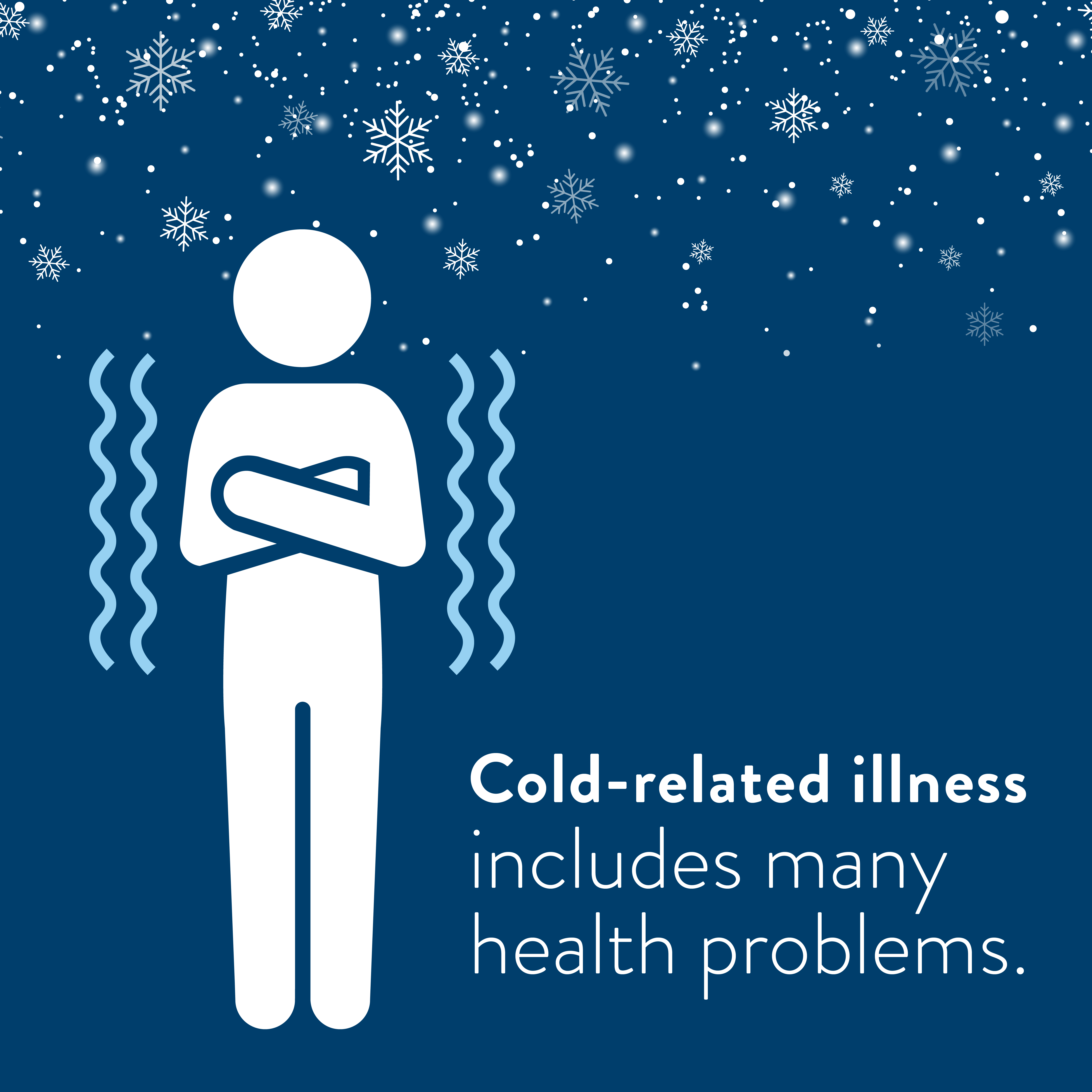Cold-related illness in Minnesota: MN Public Health Data Access Portal - MN Dept. of Health
Cold-related illness
Cold weather can impact health

During the winter months in Minnesota, the temperature outside can be very cold. Exposure to cold temperatures, winter weather conditions, or cold water can have negative impacts on your health.
When exposed to the cold, your body can lose heat faster than it can be produced. This can lead to cold-related illness or even death.
Cold-related illness includes many health problems such as hypothermia, frostbite, trench foot, or chilblains, that occur when the body becomes too cold. While these health problems are most likely at very cold temperatures, they can occur even at cool temperatures (above 40°F) if a person becomes cold from wind, rain, sweat, or cold water.
Who is most at risk for cold-related illness?
Everyone can be impacted by exposure to the cold, but some people are at greater risk for cold-related illness than others. Those who spend long periods of time outdoors in the cold may be at increased risk as well as those who have difficulty regulating their body temperature.
Populations most vulnerable to cold-related illness:
- Older adults (age 65 and older)
- Infants and young children
- People with inadequate clothing, shelter, or heating, such as those experiencing homelessness
- People who work outdoors or work in areas that are poorly insulated or without heat
- People with outdoor hobbies, such as hikers or hunters
- People who drink alcohol or use illicit drugs because alcohol causes the body to lose heat faster and can cloud appropriate decision making
- People with chronic medical conditions, including respiratory and cardiovascular disease
How can cold-related illness be prevented?
When it is very cold outside, stay inside or seek places with heating. For relief from the cold, consider visiting a mall, movie theater, or public library.
Stay safe indoors:
- Heat your home safely. Improper use of heating devices can cause carbon monoxide poisoning.
- Check the temperature in your home often during extremely cold weather
- Check on elderly friends, family, and neighbors
- Dress infants in warmer clothing such as footed pajamas, one-piece wearable blankets, or sleep sacks
- Keep pets inside or provide adequate shelter
Stay safe outdoors:
- Wear appropriate clothing, including multiple layers, and do not leave any areas of your skin exposed to the cold
- Avoid walking on ice or getting wet
- Try not to sweat or become too tired
- Avoid alcoholic or caffeinated drinks as these can lead to dehydration
- If you go hiking, camping, or skiing, let your friends and family know where you will be and be prepared to take emergency shelter
- If you work outdoors, move into warm locations during work breaks and limit the amount of time outside on extremely cold days
- Carefully watch for signs of cold-related illness, such as hypothermia and frostbite
- Do not ignore shivering – it’s an important first sign that your body is losing heat
More tips for staying safe in the cold:
Climate change considerations for cold-related illness
Minnesota’s changing climate may impact cold-related illness. Minnesota winter temperatures, especially winter lows, are warming. However, the past couple of decades show that the rate of cold-related illness is generally increasing in Minnesota.
There are many other factors, in addition to temperature, that contribute to cold-related illness and may help to explain the trends. The increase could be related to behavior patterns, such as drug or alcohol use. Other climate changes, such as more winter snow as rain, changes in freeze-thaw cycles, and periods of intense cold within mild winters may also be factors.
The Minnesota Department of Health (MDH) Climate & Health Program will continue to explore the relationship between cold-related illness and climate change as more information becomes available on climactic conditions.
What is being done about cold-related illness?
Health professionals can use cold-related illness data to inform targeted outreach and education to populations and areas at risk of cold-related illness. They can also use this data to evaluate public health actions and the effectiveness of state and local initiatives to prevent cold-related illness.
For more information on cold-related illness, winter weather, and climate change:
- The Minnesota Department of Health (MDH) Climate & Health Program has tools and resources about climate change and health in Minnesota.
- The Centers for Disease Control and Prevention (CDC) has developed resources for preparedness and response to winter weather.
- The National Institute for Occupational Safety and Health (NIOSH) has information and resources for workers who may experience cold stress.
- The Occupational Safety and Health Administration (OSHA) also has information available on winter weather preparation for businesses and workers.
Related topics:
- Assessing the Burden of Cold-related Illness and Death in Minnesota (NEHA)
- Climate-related environmental health concerns
- Heat-related illness
- Carbon monoxide poisoning
Updated February 2021. Content updates are made when data become available.